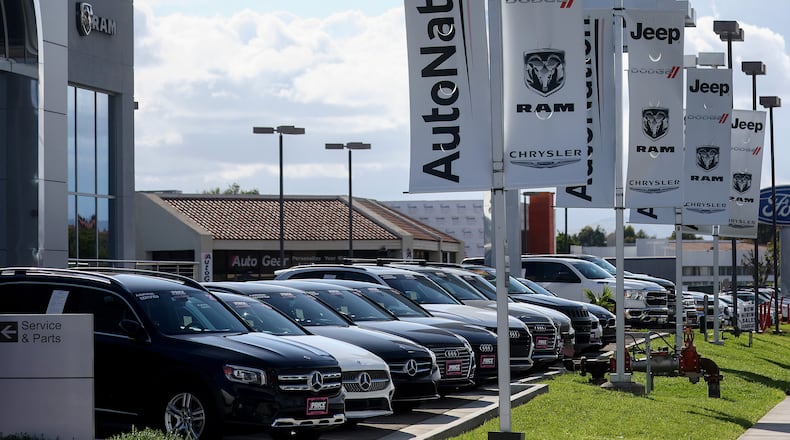Car buyers need some relief. For now, it’s wait and see.
The Federal Reserve cut the nation’s key banking rate by half a percentage point last month. That is the first cut in more than four years. Economists predict more cuts could come. But the trickle-down effect of the most recent cut will take time to reduce consumer car loan rates, and it can’t reach wallets fast enough.
“It is not likely that auto loan rates will decline much before year’s end,” Cox Automotive chief economist Jonathan Smoke says of the September rate cut.
Effects on car loans
When the Federal Reserve’s rate-setting committee cuts its key interest rate for overnight loans between banks, the reduction takes time to make its way through the economy, including on car loans. The Fed committee doesn’t meet again until Nov. 6-7.
Smoke and other economists believe additional cuts, if they come, could help push down car loan rates further, making cars more affordable for shoppers. Most buyers must finance a vehicle, as few shoppers maintain enough cash for an outright purchase.
Interest rates on new and used vehicles have remained stubbornly high during the past several years. Data from Dealertrack, a sales and finance systems provider to many U.S. car dealers, showed in late September the average new car loan interest rate is more than 9% in its most recent monthly report. Used car loans are well above 13%. The Dealertrack averages are volume-weighted, taking the total average over the month.
Consumers feel the pinch. Average monthly new car payments peaked at $795 in December 2022. In August, they fell to $737 a month. High interest rates make up a portion of that expense.
All this happened at a time when used car prices began rising because inventory was tight. A Cox Automotive analysis of vAuto data shows that the average used list price was $25,172 in August. For used car buyers, it’s not a good time to shop. For new car shoppers, it’s a buyer’s market for several brands, including Buick, Dodge, Lincoln, Mitsubishi, Ram and Mini.
How carmakers and dealerships respond
In the face of higher interest rates on new vehicles, auto manufacturers increased their incentives to lure shoppers. The latest report by Kelley Blue Book says incentives reached their highest level all year at $3,450 in August, accounting for 7.2% of the average transaction price of $47,870.
Carmakers sought additional ways to entice consumers, including special financing deals and lease offers. For example, qualified shoppers with good credit could obtain a lower interest rate of 4.49% APR financing on certified pre-owned 2019 to 2024 Subaru Crosstrek SUVs last month.
On new cars, more manufacturers offered 0% financing deals, such as Volkswagen on its 2024 Tiguan models that they need to sell as 2025 editions start to arrive on dealer lots.
What if your credit looks less than stellar? You’ll be stuck with those higher interest rates, at least for now.
Strategies to navigate today’s market when financing a car
If you need to finance a car right now, here’s what I suggest:
- Find a used car from a private seller and pay cash.
- Buy an inexpensive car from the 2024 model year. Cars that sell for less than $25,000 include the Hyundai Venue, Chevrolet Trax, Volkswagen Taos, Toyota Corolla, Kia Soul and several others.
- Look for deals from carmakers and dealerships on 2024 models because dealers need to get rid of those.
- Shop for leftover new 2023 cars from dealers burdened with inventory. We recently spotted some 2023 Dodge Hornet compact SUVs offered as new.
- Check interest rates from multiple sources before going to a dealership so you can use those as a bargaining chip if needed.
- Lease a car instead of buying one. Locked-in payments and low-money-down offers may be just the ticket for lower monthly payments.
- Consider an electric car or plug-in hybrid. You’ll find many deals on 2024 models, including on the Honda Prologue EV and others. When you buy a new or used electric vehicle or plug-in hybrid, you may qualify for a tax incentive of up to $4,000 (used) and up to $7,500 (new). Qualifying vehicles include Tesla Model Y, Rivian R1S and R1T, Ford Escape plug-in hybrid and Chrysler Pacifica plug-in hybrid.
Another strategy is to dig in your heels and wait. With more potential interest rate cuts on the horizon, waiting might just be the best strategy. For every percentage point that your auto loan decreases, your monthly payment will decrease by 3%. Also, the absolute best day of the year to buy a new car is December 31. At least by then, there could be some movement in interest rates.
Renee DeGross Valdes is a veteran reporter and editor who writes about car advice for Kelley Blue Book and Autotrader. She previously worked for CNN and The Atlanta Journal-Constitution.
The Steering Column is a weekly consumer auto column from Cox Automotive. Cox Automotive and The Atlanta Journal-Constitution are owned by parent company, Atlanta-based Cox Enterprises.
About the Author
Keep Reading
The Latest
Featured



